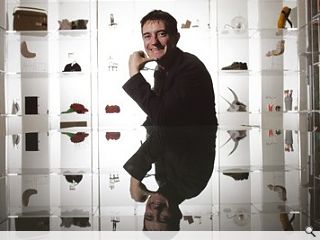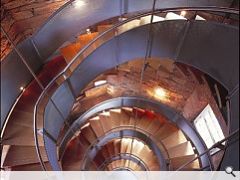Spiral of decline?
14 Nov 2008
The Lighthouse hit the headlines last month as it wrestled with a serious cash crisis. Prospect caught up with Nick Barley to find out how he proposes keeping the architecture and design centre off the rocks.
The Lighthouse, Scotland’s National Centre for Architecture and Design, has been much in the news of late. From positive headlines garnered in Venice to recent gloomier proclamations at home, Director Nick Barley has never strayed far from the limelight.The most recent fracas stems from a projected £300,000 cash flow shortfall prior to the end of this financial year, a not inconsiderable sum for an organisation posting £4,469,814 income in 2007. The blame game is already in full swing with various factors cited in defence including the omnipresent credit crunch, an overspend at the Venice Biennale and cancellation of the Six Cities Design festival.
A cash injection of £245k is “in process” by Glasgow City Council (GCC) and if approved will take the form of a loan to be repaid as conditions improve. Rebuttal of this request would place the Lighthouse in dire straits as Barley reveals: “The directors of the Lighthouse would have to decide how to proceed, the situation would be serious. We have sufficient cash to see us through Christmas so therefore we would not, I don’t think, see immediate closure. It would not be lights out at the Lighthouse.”
In order to prevent recurrence of such circumstance in future years architecture minister Linda Fabiani is asking questions of how the organisation reached its present predicament and what steps are being taken to ensure a smoother ride of the financial rollercoaster in 2009.
Staffing costs have long been a significant drain on budget with a plentiful supply of well remunerated employees. These costs have risen £319,000 from the previous year alone and now totals £1.368million. Action to remedy this state of affairs is underway with redundancy notices issued to nine people from a core staff of 42. In addition a rise of 50p is to be introduced to the Lighthouse entrance fee from March, excluding Saturday’s which shall remain free.
The Lighthouse is subject to a complex funding mechanism which sees it reliant on a unique mix of public and private revenue streams. Unlike most cultural organisations the Lighthouse employs a basket of different commercial products ranging from retail, conference, publishing and tenants to augment taxpayer hand outs. Over the past 12 months this model has held up well but in an increasingly turbulent climate the coming 12 no longer look quite so rosy.
Most major organisations within Scotland are core funded to the tune of £500,000 or more per year. The Lighthouse currently receives about £110,000 per year. More money from the government is received but that money is all earmarked to deliver specific projects at a specific cost, there is no reliability or freedom in this for the Lighthouse. From a total income of approx £4.5m in the year ended 31 March 2007 some £1.4m was swallowed up by the six cities fund, £361k by the Scottish Architectural Policy unit and £272k by the Sustainability fund.
Controversially however the Lighthouse are seeking to rebalance this weighting by tipping the scales further toward public support. Barley explains: “We accept the mix of commercial and public money in the immediate term. However we do think that there is a strong argument that we should be core funded, not just because we want to receive hand outs from the tax payer. We believe that the work we’re doing is vital not only to Scotland’s architecture community but to Scotland’s creative industries which contribute to the Scottish economy.
“The Lighthouse is not simply operating at the arty farty end of creativity but we believe our expertise is a serious business tool for Scotland. In the same way that the government invests in Scottish Enterprise or the National Galleries, we believe there is a strong argument for government and the taxpayer to invest in Scotland’s Centre for Architecture and Design, more so than it currently does. We’ve got no core funding at all.”
Barley speculates on the potential pitfalls of an unknown future: “We may have to cut our cloth in terms of future funding, I’m not making any guarantees about what we’ll do in future except to say that we’ll continue to have a world class exhibition and education programs.”
The Lighthouse building is owned by Glasgow City Council and let to the Lighthouse for a peppercorn rent of £1 per annum. Further, it’s the council’s responsibility for general upkeep, the Lighthouse’s sole liability is the operation of a visitor attraction that continues to draw people from Scotland and overseas.
To achieve these aims a refurbishment valued at £139k is proposed that will see architecturally significant office space on the first floor vacated to accommodate new exhibition space. Office space will be relocated to the smaller back end of the building. By shunting gallery space down a level this will bring the space closer to the street and free up the existing gallery four for commercial activity.
Despite the budget busting proportions of the Venice Biennale, denigrated as a “jolly” by some, Nick mounts a strident and passionate defence: “Do you accept that Scotland should have a presence on the international stage? If you do then how do you do it? We raised money from the Government, we raised significant private income. That investment I believe has been good for Scottish architecture and I will support it to the end of my days.”
In addition Venice expenditure is regarded as an investment offering returns, Barley reveals: “I can’t talk about where we’re at in terms of potential purchasers of the structure but it’s our intention that the structure doesn’t end its days in Venice but is dismantled and re-erected thereafter.”
The culmination of these efforts is the promised land of a stable financial future and Nick is adamant that the measures being pursued will act as a passport to this territory. Optimism is a commodity in short supply at the moment but Nick remains in good spirit albeit with a departing caveat, “barring unforeseen circumstances”.
Read next: Structured lives
Read previous: Book Reviews
Back to November 2008
Browse Features Archive
Search
News
For more news from the industry visit our News section.
Features & Reports
For more information from the industry visit our Features & Reports section.




